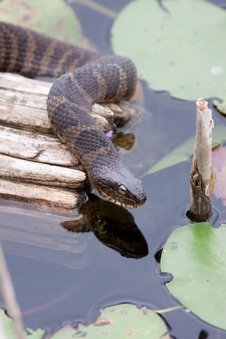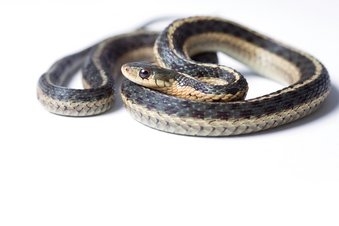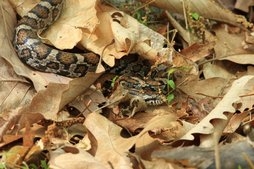Ssssssnakes! Every time I reference snakes, the scene from Indiana Jones pops into my head. There’s Indiana knee deep in snakes just slithering all around him…I get the chills just thinking about it. It’s snake season and our snake calls are on the rise. The four most common non-venomous snakes found in our area are the Black Rat, Eastern Milk, Northern Water and the Common Garter. This newsletter will provide information on all of the above mentioned except for the black rat snake. If you like to learn more about it check our new blog post about black rate snakes. Next month we will discuss the venomous snakes in our area.
Fun animal fact
Northern Water and Garter snakes give birth to live young.
Northern Water Snake
Northern water snakes can grow up to 4.5 feet long. They are typically found near rivers, brooks, wet meadows, ponds, swamps – preferably still or slow moving water, in areas with overhanging branches and rocks. Water snakes eat mostly fish, also amphibians, insects, and crayfish. They mate in April – May and again in the early fall. Northern water snakes give birth to live young in August to early October. They average 20 to 40 young but may have up to 76 young.

Common Garter Snake
Garter snakes can be 2 to 4.5 feet long, but they are typically on the smaller side. They eat mostly earthworms, but also slugs, amphibians, fish, crayfish, insects, small birds, other snakes and carrion. Garter snakes are adaptable and have a wide variety of moist areas they like to call home, from woodlands to marshes to fields. Garter snakes mate anywhere from mid-March to May, then will mate again in the fall before entering hibernation. They give birth July through early September. Garter snakes average 14 to 40 young but may have up to 85 live young.

Milk Snake
The milk snake can be up to 4.5 feet long. This snake is often confused with the northern copperhead (venomous snake). Here are some tips to assist you in distinguishing the difference between a venomous and non-venomous snake:
- Non venomous – pupils are round vs. venomous pupil is like a cat’s eye-vertical.
- Non venomous – no pit between the eye and nostril vs. venomous pit between the eye and nostril.
- Non venomous – shape of head variable, often slender vs. venomous broad, triangular-shaped head.

Milk snakes eat rodents and other snakes. They are typically found in brushy or woody cover. They are often found in barns or other areas that are home to rodents. Milk snakes mate in June and lay their eggs in mid June – July. Their eggs hatch from late August through October. Milk snakes average 13 eggs but may have up to 24.
In general, snakes are solitary by nature, but they may choose to hibernate with other snakes even those of different species. Most snakes or diurnal, except for the milk snake which is usually nocturnal. Snakes will often hibernate, usually from October/November through March/April. Snakes are generally not territorial, but are faithful to their den sites. They will re-use these sites from year to year and are sometimes found in large numbers.
To be honest, other than freaking you out, these common snakes are harmless. In fact, they are natural exterminators for many rodents that carry harmful diseases to humans. But that being said, if a snake is getting in, so can other wildlife. The best prevention for avoiding a nuisance wildlife issue with a snake is to ensure that your residential or commercial property is sealed up tight. We call it Wildlife Exclusion and it’s the best way to humanely avoid unwanted wildlife encounters. Most people pay their exterminator/pest control company a quarterly fee to ensure that no pests get in. In wildlife management, if done properly the first time, you make a one-time investment in your residential or commercial property and adhere to the habitat modification recommendations and the animal control issue is resolved. Please contact us at our toll free number 855-945-1212 or visit our website if you are interested in pursuing any of our wildlife exclusion and prevention programs.
HAPPY 4TH OF JULY….CELEBRATE YOUR FREEDOMS
AND
VOTE TO PROTECT THEM!
If you are experiencing a nuisance wildlife issue and require assistance with raccoon removal, squirrel removal, woodchuck removal, bat removal, bird removal or skunk removal, give Wildlife Busters a call toll free at 855-945-1212 and we will resolve your wildlife management issue professionally, efficiently and humanely. Please note that all of our wildlife exclusion services come with a 1 to 5 year warranty which can be extended upon expiration with one of our long-term prevention plans. Please give us a call or check out our website for more information.
To learn more about a variety of critters visit our wildlife resource.
Learn more about wildlife diseases.
Wildlife Busters is on Facebook!
Community Wildlife Programs and Upcoming Events
Mohonk Preserve
Sunday July 10th, “Natural Bug Repellent Workshop” 9:30 am – 12 pm. Sunday July 17th, “Bonticou Crag Family Hike” 10 am to 2pm. Sunday July 24th, “Butterflies and Blooms” 10 am to 12 noon. Tuesday July 26th, “Toddlers on the Trail – Stream Walk” 10 am – 12 pm. Saturday July 30th, “Dog Days of Summer Family Hike” 1 pm – 3 pm. Weds. in July 6 pm to 7:17 pm, “Evening of Yoga at the Pavillion” For more information please visit
Museum of Hudson Highlands
Saturday July 23, “Dazzling Dragon Flies” 9 am to 11 am. Saturday July 30th, “Snakes Alive” 10 am to 11:30 am.
Weinberg Nature Center
The Weinberg Nature center has weekly programs for children throughout the summer.
Beczak Environmental Education Center
Sunday July 17th, “Fish Funn” 11 am 12 noon. Saturday July 10th, Saturday July 23th and Sunday July 24th, and Saturday July 30th and Sunday July 31st “Hudson River Family Seining”, 10 pm – noon.
And for some Wildlife fun all year round visit:
The Bear Mountain Zoo located in the Bear Mountain State Park, NY
Yesterday is a dream, tomorrow but a vision. But today well-lived makes every yesterday a dream of happiness, and every tomorrow a vision of hope. Look well, therefore to this day. ~ Sanskrit Proverb

 Receive FREE wildlife Tips!
Receive FREE wildlife Tips!
